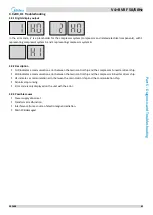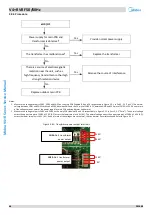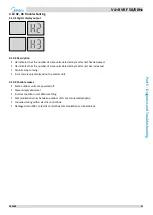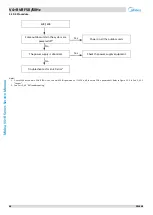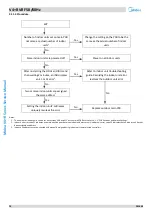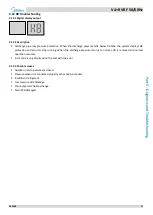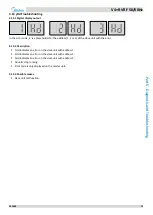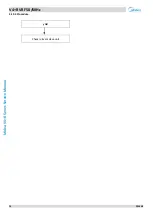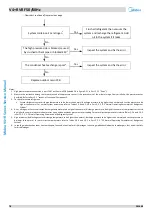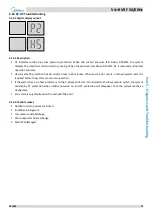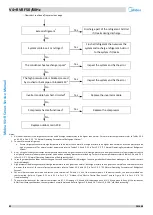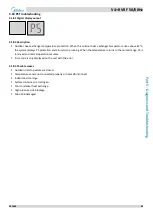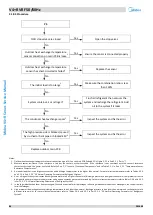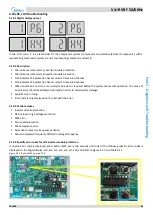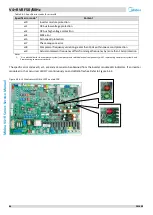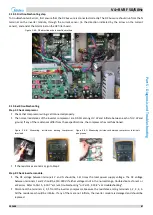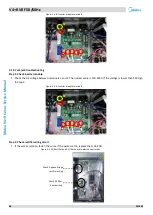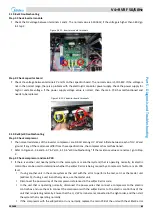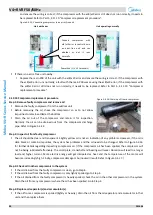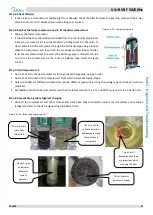
V4+R VRF 50/60Hz
76
201608
Midea V
4
+R
Se
rie
s Se
rvice
Manua
l
… flowchart continued from previous page
Insufficient refrigerant caused by
refrigerant leakage
3
Yes
Add refrigerant and inspect the system
for leaks
No
The system is blocked, caused by crushed
or bent pipe, blocked EXV or dirty filter
4
Yes
Inspect the system and fix the error. If the
filter is blocked by ice, the piping should
be cleaned
No
The indoor load is too large
5
Yes
Make sure the combination ratio is less
than 130%
No
System contains air or nitrogen
6
Yes
Flush all refrigerant then vacuum the
system and recharge refrigerant. Add oil
to the system if it leaks
No
The condenser heat exchange is poor
7
Yes
Inspect the system and fix the error
No
Replace outdoor main PCB
Notes:
1.
Compressor top temperature sensor and discharge pipe temperature sensor connections are ports CN10 and CN11 on the main PCB (labeled 1 and 2,
respectively, in Figure 5-2.1 in Part 5, 2.1 “Ports”). Discharge temperature switch connections are port CN18 on the main PCB (labeled 26 in Figure 5-2.1 in
Part 5, 2.1 “Ports”).
2.
Measure sensor resistance. If the resistance is too low, the sensor has short-circuited. If the resistance is not consistent with the sensor’s resistance
characteristics table, the sensor has failed. Refer to Part 2, 1 “Layout of Functional Components” and to Table 5-5.2 in Part 5, 5.1 “Temperature Sensor
Resistance Characteristics”.
3.
To check for insufficient refrigerant:
An insufficiency of refrigerant causes compressor discharge temperature to be higher than normal, discharge and suction pressures to be lower than
normal and compressor current to be lower than normal, and may cause frosting to occur on the suction pipe. These issues disappear once
sufficient refrigerant has been charged into the system. For normal system parameters refer to Tables 5-5.4 and 5-5.5 in Part 5, 5.2 “5.2 Normal
Operating Parameters of Refrigerant System”.
4.
A low pressure side blockage causes compressor discharge temperature to be higher than normal, suction pressure to be lower than normal and
compressor current to be lower than normal, and may cause frosting to occur on the suction pipe. For normal system parameters refer to Tables 5-5.4 and
5-5.5 in Part 5, 5.2 “5.2 Normal Operating Parameters of Refrigerant System”.
5.
An indoor load that is too large causes suction and discharge temperatures to be higher than normal. For normal system parameters refer to Tables 5-5.4
and 5-5.5 in Part 5, 5.2 “5.2 Normal Operating Parameters of Refrigerant System”.
6.
Air or nitrogen in the system causes discharge temperature to be higher than normal, discharge pressure to be higher than normal, compressor current to
be higher than normal, abnormal compressor noise and an unsteady pressure meter reading. For normal system parameters refer to Tables 5-5.4 and 5-5.5
in Part 5, 5.2 “5.2 Normal Operating Parameters of Refrigerant System”.
7.
In cooling mode check outdoor heat exchangers, fans and air outlets for dirt/blockages. In heating mode check indoor heat exchangers, fans and air outlets
for dirt/blockages.
Содержание V4+R Series
Страница 2: ......
Страница 4: ...V4 R VRF 50 60Hz 2 201608 Midea V4 R Series Service Manual ...
Страница 39: ...V4 R VRF 50 60Hz 201702 37 Part 4 Field Settings Part 4 Field Settings 1 Outdoor Unit Field Settings 38 ...
Страница 76: ...V4 R VRF 50 60Hz 74 201608 Midea V4 R Series Service Manual Procedure 4 13 4 yHd Check relevant slave unit ...
Страница 103: ......




